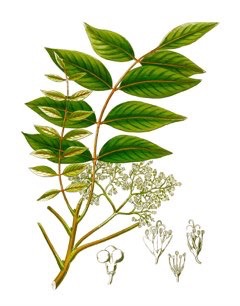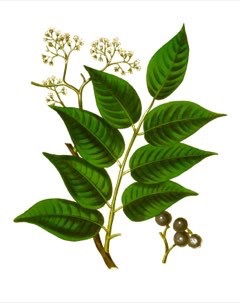 |
|
http://www.edibleplants.org |
 |
| http://www.edibleplants.org |
Translate this page:
Summary
A tropical plant growing up to 25 m in height, Picrasma excelsa or commonly known as Jamaican Quassia can be found in Northern South America to Central America and the Caribbean. It is primarily cultivated for medicinal uses. The bark is used to reduce fever, improve appetite and digestion. It is also used against malaria and anorexia. Externally, it is used against lice, threadworms, and other parasites. Extract from the bark is also used as flavoring in food and drinks. Another use of the bark is for insect control for it has insecticide properties. The wood of Jamaican Quassia is soft, light, and easily split.
Physical Characteristics

 Picrasma excelsa is a deciduous Tree growing to 20 m (65ft) by 15 m (49ft) at a medium rate.
Picrasma excelsa is a deciduous Tree growing to 20 m (65ft) by 15 m (49ft) at a medium rate.
See above for USDA hardiness. It is hardy to UK zone 10.
Suitable for: light (sandy) and medium (loamy) soils and prefers well-drained soil. Suitable pH: mildly acid, neutral and basic (mildly alkaline) soils. It cannot grow in the shade. It prefers moist soil.
UK Hardiness Map
US Hardiness Map
Synonyms
Picraena excelsa (Sw.) Lindl. Quassia excelsa Sw.
Plant Habitats
Edible Uses
Edible Parts: Inner bark
Edible Uses:
The bitter extract of the bark is used as a flavouring in drinks, baked goods, candy etc[238 , 301 ].
References More on Edible Uses
Medicinal Uses
Plants For A Future can not take any responsibility for any adverse effects from the use of plants. Always seek advice from a professional before using a plant medicinally.
Appetizer Bitter Febrifuge Malaria Parasiticide
Jamaican quassia bark contains several medically active constituents including quassinoid bitter principles (including quassin); alkaloids; a coumarin, scopoletin; and vitamin B1[254 ]. It is an intensely bitter, non-astringent, odourless herb that lowers fever, stimulates appetite and improves digestion[238 ]. It is an effective parasiticide and is reputedly antileukaemic[238 ]. Some of the quassinoids have been shown to have cytotoxic and antileukaemic actions[254 ]. The strongly bitter principle in the bark supports and strengthens weak digestive systems, increasing bile flow plus the secretion of salivary juices and stomach acids[254 ]. It is used internally in the treatment of a wide range of illnesses where digestion is a contributory factor, particularly convalescent debility, poor appetite and anorexia[238 , 254 ]. Its bitterness has led to it being used in the treatment of malaria and other fevers[238 , 254 ]. It is also used to rid the body of nematode worms[238 ]. Used externally, it is a good lotion to get rid of parasites such as lice[238 ]. It is also used in an enema to rid the body of threadworms and other parasites[238 , 254 ]. The bark can be harvested as required throughout the year, and can be dried for later use[254 ].
References More on Medicinal Uses
The Bookshop: Edible Plant Books
Our Latest books on Perennial Plants For Food Forests and Permaculture Gardens in paperback or digital formats.

Edible Tropical Plants
Food Forest Plants for Hotter Conditions: 250+ Plants For Tropical Food Forests & Permaculture Gardens.
More

Edible Temperate Plants
Plants for Your Food Forest: 500 Plants for Temperate Food Forests & Permaculture Gardens.
More

More Books
PFAF have eight books available in paperback and digital formats. Browse the shop for more information.
Shop Now
Other Uses
Insecticide Parasiticide Repellent
Other Uses: The decocted bark is an effective insecticide against flies, red spider mites, aphids and woolly aphids[238 ]. It is used as an insect repellent[254 ]. The white to yellowish-white wood is soft, light, loosely grained, easily split[46 ].
Special Uses
References More on Other Uses
Cultivation details
Prefers a fertile, humus-rich, moisture-retentive sandy loam[238 ].
References Carbon Farming Information and Carbon Sequestration Information
Temperature Converter
Type a value in the Celsius field to convert the value to Fahrenheit:
Fahrenheit:
The PFAF Bookshop
Plants For A Future have a number of books available in paperback and digital form. Book titles include Edible Plants, Edible Perennials, Edible Trees,Edible Shrubs, Woodland Gardening, and Temperate Food Forest Plants. Our new book is Food Forest Plants For Hotter Conditions (Tropical and Sub-Tropical).
Shop Now
Plant Propagation
Seed - best sown as soon as it is ripe. Semi-ripe cuttings.
Other Names
If available other names are mentioned here
bitter wood, bitter-ash, bitterved, bitterwood, bois noyer, jamaica quassia, jamaica quassiawood, jamaika-bitterholz, peste à poux, quassia, quassia amara, quassia da jamaica, quassia de la jamaique, quassia de surinam, quassie, simaroube officinale, simaruba, simarubabaum, surinam quassia.
Native Range
SOUTHERN AMERICA: Antigua and Barbuda (Antigua), Barbados, Cuba, Dominica, Dominican Republic, Guadeloupe, Haiti, Jamaica, St. Kitts and Nevis, St. Lucia, Montserrat, Martinique, United States (Puerto Rico, Virgin Islands, U.S.), St. Vincent and Grenadines (Saint Vincent), Virgin Islands (British) (Tortola), Costa Rica, Nicaragua, Venezuela
Weed Potential
Right plant wrong place. We are currently updating this section.
Please note that a plant may be invasive in one area but may not in your area so it's worth checking.
Conservation Status
IUCN Red List of Threatened Plants Status : Status: Vulnerable A1cd

Growth: S = slow M = medium F = fast. Soil: L = light (sandy) M = medium H = heavy (clay). pH: A = acid N = neutral B = basic (alkaline). Shade: F = full shade S = semi-shade N = no shade. Moisture: D = dry M = Moist We = wet Wa = water.
Now available:
Food Forest Plants for Mediterranean Conditions
350+ Perennial Plants For Mediterranean and Drier Food Forests and Permaculture Gardens.
[Paperback and eBook]
This is the third in Plants For A Future's series of plant guides for food forests tailored to
specific climate zones. Following volumes on temperate and tropical ecosystems, this book focuses
on species suited to Mediterranean conditions—regions with hot, dry summers and cool, wet winters,
often facing the added challenge of climate change.
Read More
Expert comment
Author
(Sw.) Planch.
Botanical References
Links / References
For a list of references used on this page please go here
A special thanks to Ken Fern for some of the information used on this page.
Readers comment
| Add a comment |
|
If you have important information about this plant that may help other users please add a comment or link below. Only comments or links that are felt to be directly relevant to a plant will be included. If you think a comment/link or information contained on this page is inaccurate or misleading we would welcome your feedback at [email protected]. If you have questions about a plant please use the Forum on this website as we do not have the resources to answer questions ourselves.
* Please note: the comments by website users are not necessarily those held by PFAF and may give misleading or inaccurate information.
To leave a comment please Register or login here All comments need to be approved so will not appear immediately.
|
Subject : Picrasma excelsa
|
|
|
|